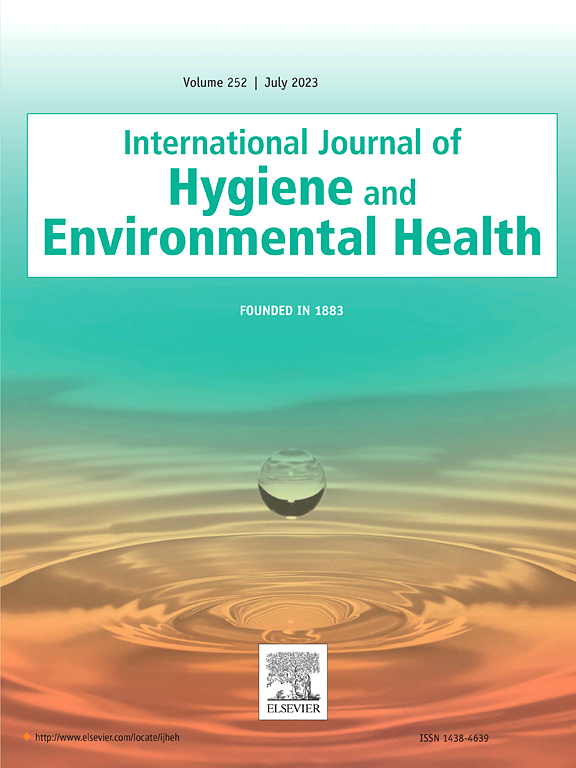Time-trends of blood lead levels from 2020 to 2023 in pregnant and breastfeeding women from Adjara, Georgia—A birth registry-based study
IF 4.5
2区 医学
Q1 INFECTIOUS DISEASES
International journal of hygiene and environmental health
Pub Date : 2024-10-30
DOI:10.1016/j.ijheh.2024.114482
引用次数: 0
Abstract
Background
In response to substantial lead exposure, the autonomous republic of Adjara in Georgia initiated complementary blood lead level (BLL) testing for pregnant women as part of their antenatal care services in 2020.
Objectives
To study the background BLLs in pregnant and breastfeeding women in Adjara and explore the time-trends of BLLs from September 2020 to July 2023.
Methods
We used data on BLLs during pregnancy or postpartum from the lead screening program in Adjara, combined with data from the Georgian Birth Registry, totaling 9,510 women. To study the temporal changes in BLLs, we used independent samples t-tests and chi-square tests.
Results
In 2020, the mean (standard deviation [SD]) BLL was 8.8 (5.4) μg/dL, declining annually by 1.0–2.2 μg/dL to reach 3.6 (2.5) μg/dL in 2023. The prevalence of pregnant women with BLLs ≥3.5, ≥5.0, and ≥10.0 μg/dL also decreased from 2020 to 2023. Specifically, 21.2% of women in their first trimester had BLLs ≥10 μg/dL in 2020, compared with 2.3% in 2023. Similarly, 73.5% had BLLs ≥5.0 μg/dL in 2020, which declined to 20.4% in 2023. Lastly, 89.1% had BLLs ≥3.5 μg/dL in 2020, decreasing to 38.6% in 2023.
Discussion
In 2023, nearly 40% of women in their first trimester had BLLs of ≥3.5 μg/dL, a level considered the reference value in the United States (US) and corresponding to the 97.5th percentile among US children. From 2020 to 2023, the mean BLL in pregnant women decreased by 59%, accompanied by a considerable decline in the prevalence of women with BLLs ≥3.5, ≥5.0, and ≥10.0 μg/dL. Despite the encouraging downward trend in BLLs throughout the study period, our data indicate that a considerable number of fetuses continue to be exposed to harmful levels of lead and that lead exposure remains a significant public health challenge in Adjara.
2020 年至 2023 年格鲁吉亚阿贾拉孕妇和哺乳期妇女血铅水平的时间趋势--基于出生登记的研究
背景为了应对大量的铅暴露,格鲁吉亚的阿扎尔自治共和国于 2020 年开始对孕妇进行补充性血铅水平(BLL)检测,作为产前保健服务的一部分。方法我们使用了来自阿扎尔铅筛查计划的孕期或产后 BLL 数据,以及格鲁吉亚出生登记处的数据,共计 9510 名妇女。结果 2020 年,BLL 平均值(标准差 [SD])为 8.8 (5.4) μg/dL,每年下降 1.0-2.2 μg/dL,到 2023 年达到 3.6 (2.5) μg/dL。从 2020 年到 2023 年,BLL 值≥3.5、≥5.0 和≥10.0 μg/dL 的孕妇患病率也有所下降。具体来说,2020 年有 21.2% 的怀孕头三个月的妇女 BLL ≥10 μg/dL,而 2023 年仅为 2.3%。同样,2020 年 BLL≥5.0 μg/dL 的女性占 73.5%,2023 年降至 20.4%。最后,2020 年有 89.1% 的孕妇 BLL≥3.5 μg/dL,2023 年降至 38.6%。讨论 2023 年,近 40% 的怀孕前三个月的孕妇 BLL≥3.5 μg/dL,这一水平被认为是美国的参考值,相当于美国儿童的 97.5 百分位数。从 2020 年到 2023 年,孕妇 BLL 平均值下降了 59%,同时 BLL ≥3.5、≥5.0 和≥10.0 μg/dL 的妇女患病率也大幅下降。尽管在整个研究期间 BLL 呈下降趋势,令人鼓舞,但我们的数据表明,相当多的胎儿仍然暴露在有害的铅含量中,铅暴露仍然是阿扎尔地区公共卫生面临的一个重大挑战。
本文章由计算机程序翻译,如有差异,请以英文原文为准。
求助全文
约1分钟内获得全文
求助全文
来源期刊
CiteScore
11.50
自引率
5.00%
发文量
151
审稿时长
22 days
期刊介绍:
The International Journal of Hygiene and Environmental Health serves as a multidisciplinary forum for original reports on exposure assessment and the reactions to and consequences of human exposure to the biological, chemical, and physical environment. Research reports, short communications, reviews, scientific comments, technical notes, and editorials will be peer-reviewed before acceptance for publication. Priority will be given to articles on epidemiological aspects of environmental toxicology, health risk assessments, susceptible (sub) populations, sanitation and clean water, human biomonitoring, environmental medicine, and public health aspects of exposure-related outcomes.

 求助内容:
求助内容: 应助结果提醒方式:
应助结果提醒方式:


